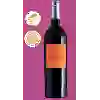
Winery SinglaCuve No. 5
In the mouth this red wine is a powerful with a nice balance between acidity and tannins.
This wine generally goes well with beef, veal or pasta.
Taste structure of the Cuve No. 5 from the Winery Singla
Light | Bold | |
Smooth | Tannic | |
Dry | Sweet | |
Soft | Acidic |
In the mouth the Cuve No. 5 of Winery Singla in the region of Pays d'Oc is a powerful with a nice balance between acidity and tannins.
Food and wine pairings with Cuve No. 5
Pairings that work perfectly with Cuve No. 5
Original food and wine pairings with Cuve No. 5
The Cuve No. 5 of Winery Singla matches generally quite well with dishes of beef, pasta or veal such as recipes of wild boar stew in burgundy style, very simple spaghetti carbonara or osso buco with mushrooms.
Details and technical informations about Winery Singla's Cuve No. 5.
Discover the grape variety: Frankenthal
It is said to be of Austrian origin, from the Tyrol to be precise, and for some it comes from Franconia in Germany. Some ampelographers consider that Frankenthal and Kavcina crna or Zametovka grown in Slovenia are identical, with perhaps only a few clonal differences, which have yet to be confirmed, although it is true that they all have a large number of synonyms in common. Frankenthal can still be found in Belgium, the Netherlands, Germany, Austria, Hungary, Slovenia, Croatia, Italy, Portugal, England, Chile and Australia. For a long time, it was cultivated under greenhouses as a table grape in the North, East and West of France. Today, it has been almost abandoned and is therefore in danger of disappearing.
Last vintages of this wine
The best vintages of Cuve No. 5 from Winery Singla are 2016
Informations about the Winery Singla
The Winery Singla is one of of the world's great estates. It offers 28 wines for sale in the of Côtes Catalanes to come and discover on site or to buy online.
The wine region of Côtes Catalanes
The wine region of Côtes Catalanes is located in the region of Pays d'Oc of Vin de Pays of France. Wineries and vineyards like the Château de l'Ou or the Domaine Department 66 produce mainly wines red, white and pink. The most planted grape varieties in the region of Côtes Catalanes are Mourvèdre, Viognier and Cabernet-Sauvignon, they are then used in wines in blends or as a single variety. On the nose of Côtes Catalanes often reveals types of flavors of grapefruit, saline or pink grapefruit and sometimes also flavors of watermelon, nectarine or wax.
The wine region of Pays d'Oc
Pays d'Oc is the PGI for red, white and rosé wines that are produced over a wide area of the southern coast of France. The PGI catchment area corresponds roughly to the Languedoc-roussillon">Languedoc-Roussillon wine region, one of the largest wine regions in France. The area covers all wines that are not produced under the strict laws that govern AOC-level appellations in the regions: among them, Corbières, Minervois and the Languedoc appellation itself. The Pays d'Oc PGI is arguably the most important in France, producing the majority of the country's PGI wines.
The word of the wine: Hautain (en)
Pruning of the vine in height.













